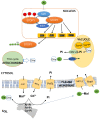Research Advances in the Mutual Mechanisms Regulating Response of Plant Roots to Phosphate Deficiency and Aluminum Toxicity
- PMID: 35163057
- PMCID: PMC8835462
- DOI: 10.3390/ijms23031137
Research Advances in the Mutual Mechanisms Regulating Response of Plant Roots to Phosphate Deficiency and Aluminum Toxicity
Abstract
Low phosphate (Pi) availability and high aluminum (Al) toxicity constitute two major plant mineral nutritional stressors that limit plant productivity on acidic soils. Advances toward the identification of genes and signaling networks that are involved in both stresses in model plants such as Arabidopsis thaliana and rice (Oryza sativa), and in other plants as well have revealed that some factors such as organic acids (OAs), cell wall properties, phytohormones, and iron (Fe) homeostasis are interconnected with each other. Moreover, OAs are involved in recruiting of many plant-growth-promoting bacteria that are able to secrete both OAs and phosphatases to increase Pi availability and decrease Al toxicity. In this review paper, we summarize these mutual mechanisms by which plants deal with both Al toxicity and P starvation, with emphasis on OA secretion regulation, plant-growth-promoting bacteria, transcription factors, transporters, hormones, and cell wall-related kinases in the context of root development and root system architecture remodeling that plays a determinant role in improving P use efficiency and Al resistance on acidic soils.
Keywords: acidic soil; aluminum toxicity; organic acids; phosphate deficiency; signal crosstalk; stress response.
Conflict of interest statement
The authors have no conflict of interest to declare.
Figures



Similar articles
-
Modulation of Phosphate Deficiency-Induced Metabolic Changes by Iron Availability in Arabidopsis thaliana.Int J Mol Sci. 2021 Jul 16;22(14):7609. doi: 10.3390/ijms22147609. Int J Mol Sci. 2021. PMID: 34299231 Free PMC article.
-
Root architecture remodeling induced by phosphate starvation.Plant Signal Behav. 2011 Aug;6(8):1122-6. doi: 10.4161/psb.6.8.15752. Epub 2011 Aug 1. Plant Signal Behav. 2011. PMID: 21778826 Free PMC article. Review.
-
Root transcriptome of two contrasting indica rice cultivars uncovers regulators of root development and physiological responses.Sci Rep. 2016 Dec 21;6:39266. doi: 10.1038/srep39266. Sci Rep. 2016. PMID: 28000793 Free PMC article.
-
Characterization of contrasting rice (Oryza sativa L.) genotypes reveals the Pi-efficient schema for phosphate starvation tolerance.BMC Plant Biol. 2021 Jun 21;21(1):282. doi: 10.1186/s12870-021-03015-4. BMC Plant Biol. 2021. PMID: 34154533 Free PMC article.
-
Phenotypes and Molecular Mechanisms Underlying the Root Response to Phosphate Deprivation in Plants.Int J Mol Sci. 2023 Mar 7;24(6):5107. doi: 10.3390/ijms24065107. Int J Mol Sci. 2023. PMID: 36982176 Free PMC article. Review.
Cited by
-
Commonalities and Specificities in Wheat (Triticum aestivum L.) Responses to Aluminum Toxicity and Low Phosphorus Revealed by Transcriptomics and Targeted Metabolomics.Int J Mol Sci. 2024 Aug 27;25(17):9273. doi: 10.3390/ijms25179273. Int J Mol Sci. 2024. PMID: 39273221 Free PMC article.
-
Identification of the ALMT gene family in the potato (Solanum tuberosum L.) and analysis of the function of StALMT6/10 in response to aluminum toxicity.Front Plant Sci. 2023 Nov 20;14:1274260. doi: 10.3389/fpls.2023.1274260. eCollection 2023. Front Plant Sci. 2023. PMID: 38053773 Free PMC article.
-
Combined de novo transcriptomic and physiological analyses reveal RyALS3-mediated aluminum tolerance in Rhododendron yunnanense Franch.Front Plant Sci. 2022 Aug 10;13:951003. doi: 10.3389/fpls.2022.951003. eCollection 2022. Front Plant Sci. 2022. PMID: 36035662 Free PMC article.
-
Genome-Wide Identification and Expression Assessment for the Phosphate Transporter 2 Gene Family Within Sweet Potato Under Phosphorus Deficiency Stress.Int J Mol Sci. 2025 Mar 17;26(6):2681. doi: 10.3390/ijms26062681. Int J Mol Sci. 2025. PMID: 40141323 Free PMC article.
-
Pioneer Tree Bellucia imperialis (Melastomataceae) from Central Amazon with Seedlings Highly Dependent on Arbuscular Mycorrhizal Fungi.J Fungi (Basel). 2023 May 2;9(5):540. doi: 10.3390/jof9050540. J Fungi (Basel). 2023. PMID: 37233251 Free PMC article.
References
-
- von Uexküll H.R., Mutert E. Global extent, development and economic impact of acid soils. Plant Soil. 1995;171:1–15. doi: 10.1007/BF00009558. - DOI
-
- Ryan P.R., Ditomaso J.M., Kochian L.V. Aluminum toxicity in roots: An investigation of spatial sensitivity and the role of the root cap. J. Exp. Bot. 1993;44:437–446. doi: 10.1093/jxb/44.2.437. - DOI
Publication types
MeSH terms
Substances
Grants and funding
LinkOut - more resources
Full Text Sources
Research Materials
Miscellaneous

